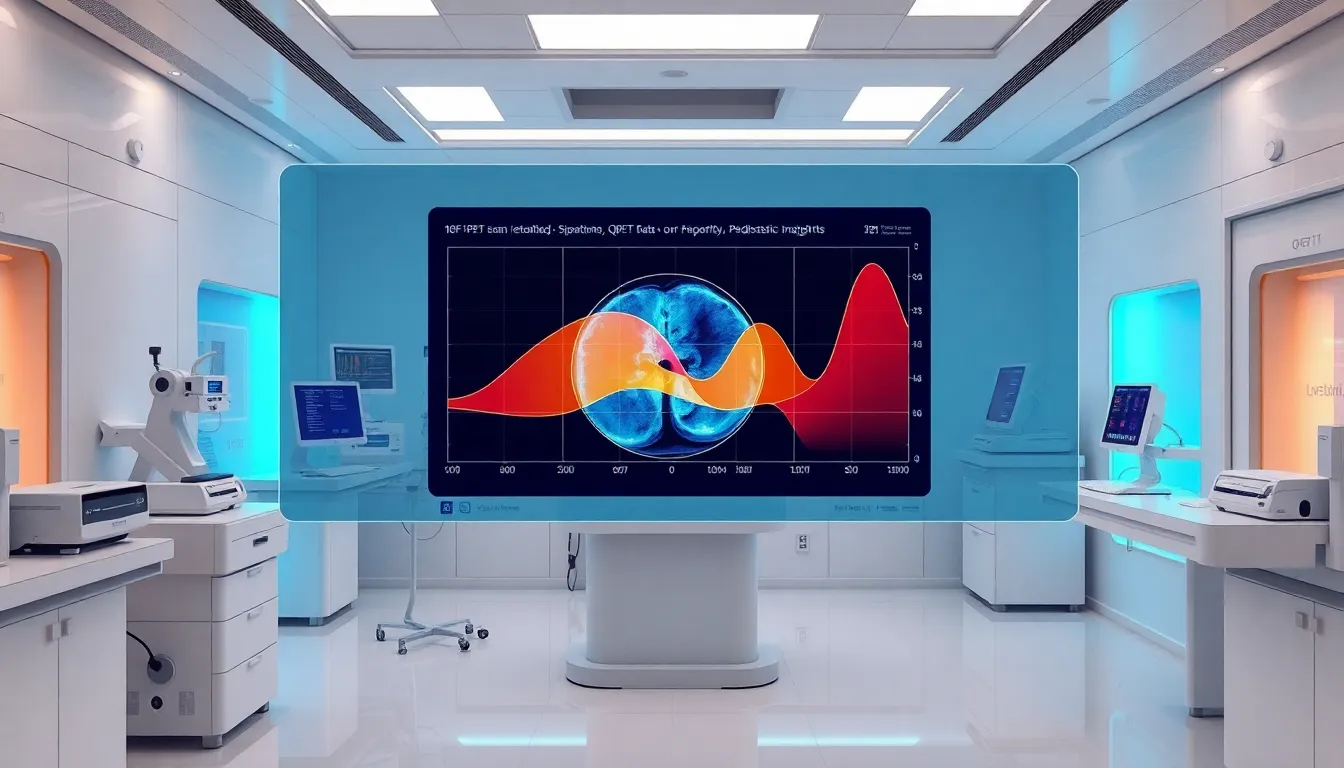Transforming prognostic insights for pediatric Hodgkin lymphoma, the study “Quantitative Deauville Scoring to Uncover Prognostic Information from 18F-FDG PET–Based Response Assessment: Data from the EuroNet-PHL-C1 Trial” highlights how qPET scoring significantly refines patient assessment. This quantitative method reveals a remarkable 41.4% difference in 60-month event-free survival rates, differentiating prognostic groups that traditional visual methods could not.
Key Implications:
- Quantitative qPET enables safe de-escalation of therapy, such as omitting radiotherapy, for pediatric Hodgkin lymphoma patients with highly favorable qPET values (less than 1.3) who show excellent 60-month event-free survival.
- qPET values between 1.3 and 3 indicate that established standard chemotherapy and radiotherapy protocols remain appropriate, ensuring effective disease management for patients with moderate risk profiles.
- For patients with unacceptably low 60-month event-free survival (47.6%) indicated by qPET values greater than 3, the biomarker strongly justifies the need for more aggressive and intensive treatment strategies.

Quantitative qPET Reveals 41.4% Survival Difference in Pediatric Lymphoma
Recent advancements in imaging assessment, specifically quantitative Deauville scoring, are transforming prognostic insights for pediatric Hodgkin lymphoma. The study, “Quantitative Deauville Scoring to Uncover Prognostic Information from 18F-FDG PET–Based Response Assessment: Data from the EuroNet-PHL-C1 Trial,” highlights how qPET scoring significantly refines prognostic assessment. It reveals distinct 60-month event-free survival (EFS) rates that the traditional visual Deauville Scale (vDS) could not differentiate. This quantitative approach identified a remarkable 41.4% difference in 60-month EFS between the most and least favorable prognostic groups (EuroNet-PHL-C1 Trial).
Methodology of qPET Assessment
Quantitative qPET scoring offers a more precise, continuous measurement compared to the subjective ordinal scale of the visual Deauville Score (vDS). For this study, qPET was defined as the quotient of the SUVpeak of the lymphoma residual and the SUVmean of the liver. This metric was measured retrospectively in 1,447 pediatric Hodgkin lymphoma patients from the EuroNet-PHL-C1 trial. The assessment focused on the lesion with the highest determined vDS after two cycles of vincristine, etoposide, prednisone, and doxorubicin (VEPD) chemotherapy. This systematic methodology provides a standardized and objective way to evaluate treatment response.
Granular Prognostic Insights Beyond Visual Deauville
The power of quantitative qPET lies in its ability to provide granular prognostic insights, moving beyond the broader categories of the visual Deauville Scale. Patients with qPET less than 1.3 showed an approximate 89% 60-month Event-Free Survival. This favorable outcome aligns with the standard for complete metabolic remission (visual Deauville Score ≤3). For those with qPET between 1.3 and 2, corresponding to an initial visual Deauville Score 4, the 60-month EFS was 84.3%. These findings demonstrate a clear correlation between lower qPET values and superior long-term survival rates.
Crucially, qPET effectively segmented categories that the vDS previously grouped together. For instance, the traditional visual Deauville Score 5 category, typically indicative of higher disease activity, was further differentiated. A specific subgroup of these patients, with qPET between 2 and 3, yielded an 83.1% 60-month EFS. This contrasts sharply with a high-risk subgroup, also initially categorized with a visual Deauville Score 5, but with qPET greater than 3, who showed a significantly lower 47.6% 60-month EFS. This segmentation highlights qPET’s unique ability to uncover hidden prognostic distinctions within seemingly uniform visual assessments.
Enhanced Risk Stratification and Survival Prediction
The continuous nature of quantitative qPET scoring offers a superior method for identifying patients with significantly different survival rates within broader visual Deauville Score classifications. The ability to segment the visual Deauville Score 5 category into two distinct prognostic groups, with 60-month EFS rates of 83.1% and 47.6%, is a major breakthrough. This refined stratification provides clinicians with a more accurate tool for risk assessment after two cycles of VEPD chemotherapy. It helps to tailor subsequent treatment intensity more effectively.
Overall, quantitative qPET differentiated a substantial 41.4% difference in 60-month EFS between the most favorable (qPET < 1.3, 89%) and least favorable (qPET > 3, 47.6%) prognostic groups. This significantly enhances risk stratification capabilities beyond the ordinal visual Deauville Scale. Implementing quantitative Deauville scoring to uncover prognostic information from 18F-FDG PET–based response assessment could lead to more personalized and effective treatment strategies for pediatric Hodgkin lymphoma patients.

Precise qPET Thresholds Tailor Therapy, Improving Patient Outcomes
Advances in pediatric oncology are continuously seeking methods to refine treatment intensity, ensuring efficacy while minimizing long-term side effects. A significant breakthrough comes from the application of a quantitative approach to quantitative Deauville scoring, specifically the qPET biomarker, which enables data-driven adjustments to treatment strategies for pediatric Hodgkin lymphoma patients. This innovative approach optimizes therapy intensity based on precise 60-month event-free survival (EFS) predictions, leveraging insights from 18F-FDG PET-based response assessment (EuroNet-PHL-C1 trial).
This comprehensive analysis, derived from the multicentric EuroNet-PHL-C1 trial, involved a specific cohort of 1,447 patients newly diagnosed with pediatric Hodgkin lymphoma. Assessments were rigorously performed after just two cycles of VEPD, a common chemotherapy regimen. The findings from this study, focusing on Quantitative Deauville Scoring to Uncover Prognostic Information from 18F-FDG PET–Based Response Assessment: Data from the EuroNet-PHL-C1 Trial, provide clear, evidence-based guidelines for tailoring treatment.
De-escalating Therapy: Optimizing for Favorable Outcomes
For patients exhibiting highly favorable responses, the qPET biomarker offers a pathway to de-escalate treatment. Specifically, patients with qPET values less than 1.3 demonstrated an impressive 89% 60-month EFS (event-free survival). Such strong prognostic indicators confirm highly favorable outcomes for this group. Based on this robust data, omitting radiotherapy from their treatment plans is strongly supported, thereby reducing exposure to potential long-term complications without compromising survival rates. This precision helps in avoiding overtreatment for a significant portion of young patients.
Maintaining Standard Care for Moderate Risk
The qPET scoring system also provides clear guidance for patients with moderate risk profiles. Individuals with qPET values falling between 1.3 and 3 exhibited 60-month EFS rates ranging from 83.1% to 84.3%. These outcomes indicate that the established standard treatment protocol—comprising both chemotherapy and radiotherapy—is entirely sufficient for these patients. This group benefits from a balanced approach, receiving adequate treatment intensity to manage their disease effectively while adhering to widely accepted clinical standards informed by precise quantitative data (EuroNet-PHL-C1 trial).
Intensifying Treatment for Unacceptably Low Survival Rates
Perhaps the most critical application of the qPET biomarker lies in identifying patients who require more intensive intervention. Patients whose qPET values were greater than 3 faced a significantly challenging prognosis, with a starkly low 47.6% 60-month EFS. This outcome is considered unacceptably low and underscores a critical need for new, more aggressive, and intensive treatment strategies. The quantitative insights provided by qPET strongly justify immediate adjustments to therapy for these high-risk patients, pushing for innovative approaches to improve their survival rates dramatically.
In conclusion, leveraging precise quantitative prognostic information derived from 18F-FDG PET scans through the qPET biomarker represents a transformative step in managing pediatric Hodgkin lymphoma. This tailored approach enables clinicians to make informed, data-driven decisions regarding treatment intensity, allowing for de-escalation, maintenance of standard care, or intensification of therapy based on quantifiable risk. This strategy aims to meticulously avoid both overtreatment and undertreatment, significantly improving patient outcomes by optimizing individual treatment pathways through a refined Quantitative Deauville Scoring to Uncover Prognostic Information from 18F-FDG PET–Based Response Assessment: Data from the EuroNet-PHL-C1 Trial.
Featured image generated using Flux AI
Journal of Nuclear Medicine: “Quantitative Deauville Scoring to Uncover Prognostic Information from 18F-FDG PET–Based Response Assessment: Data from the EuroNet-PHL-C1 Trial”
